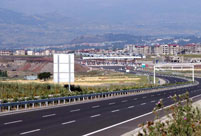 Beautiful Chinese-built roads in Africa
Beautiful Chinese-built roads in Africa Sagya Monastery in Tibet
Sagya Monastery in Tibet
 Young Chinese drive consumption
Young Chinese drive consumption
 The life of a model: Not as glamorous as it seems
The life of a model: Not as glamorous as it seems
 Hello Kitty, happy 40th birthday!
Hello Kitty, happy 40th birthday!
 The Western Qing Mausoleum
The Western Qing Mausoleum
 Avant-garde approach to graduation photos
Avant-garde approach to graduation photos
 Early PLA posters, signatures of an era
Early PLA posters, signatures of an era
 First Russian Street in Tianjin open to public
First Russian Street in Tianjin open to public
 Motorcycle stunt on the Bund
Motorcycle stunt on the Bund
MILAN, Italy, May 7 -- The path of Italian automaker Fiat outside national borders has highlighted the weakness of the country's industrial system which is in need of a solid "vision," local experts told Xinhua in recent interviews.
Fiat Chrysler Automobiles CEO Sergio Marchionne earlier this week unveiled the five-year plan for the newly merged automaker, which aims to see a combined output of around seven million autos per year by 2018.
Marchionne had been working on this fusion, which resulted in the world's seventh largest automaker, since Fiat acquired a stake in Chrysler in 2009, in a rescue operation backed by the U.S. government. Last January, Fiat took full ownership of Chrysler.
MARCHIONNE'S "MAGIC" HAS BROUGH FIAT OUTSIDE ITALY
Since he took the helm of Fiat 10 years ago, Marchionne "has worked magic" keeping the crisis-hit company open without any capital increases from shareholders, Marco Cobianchi, an economic journalist at Panorama magazine and book writer, said.
But in his view, it is also fundamental to recognize that Fiat "has been backed by the Italian State for decades costing the country billions of euros" until "in fact, it was acquired by Chrysler."
"That is to say that Marchionne has made an extraordinary operation, but it was Fiat that became American and not Chrysler that became Italian," Cobianchi pointed out.
Numerous factors, including the transfer of the group's headquarters from Turin in Italy, where Fiat was founded in 1899, to Detroit in the United States, were the evidence that Fiat has left its home country, he added.
In his book about Fiat titled "American Dream," also published earlier this week, Cobianchi has analyzed some figures of the group.
Keeping the two companies' accounts separate, last year Chrysler sales went "very well" while Fiat sales went "very badly," the author noted.
In 2013 Chrysler gained 1.8 billion euros (2.5 billion U.S. dollars) while Fiat lost 911 million euros, he explained to Xinhua. According to official estimates, Fiat only sold 374,000 vehicles last year.
"This means Fiat's five factories in Italy are more at risk today than before the fusion," which is not promising for the country's industrial system, considered that each job place at Fiat creates another four job places in satellite activities, Cobianchi highlighted.
FROM SYMBOL OF CAPITALISM TO SIGNAL OF INDUSTRIAL WEAKNESS
After more than 100 years since it was created by a group of notables, Fiat was faced with mounting financial difficulties in its automobile division in the first 2000s, Giuseppe Berta, a business professor at Bocconi University in Milan, noted.
"Fiat stopped being the symbol of Italy's capitalism and, because of its profound crisis, underwent a transformation that brought it outside the Italian borders," he said.
"Marchionne was appointed CEO by the company's main shareholder, the Agnelli family, during the worst period that Fiat had ever experienced," he added.
When the company was close to splitting in 2004, the professor told Xinhua, Marchionne had the big merit of assuring Fiat's "temporary survival" by reducing managerial bureaucracy and refocusing the business on markets and profit.
"However, from what I perceived and also from the conversations that I had with Marchionne, I can say the CEO knew from the beginning that Fiat would not have been able to survive alone," Berta stressed.
Fiat wanted to operate in all market segments, the professor noted, but the size of its business was not sufficient to reach this goal.
"While he was restructuring Fiat, Marchionne was searching the only possible way to save Fiat, which came with Chrysler's crisis in 2009," he said.
The manager was able to carry out a "notably convenient" operation for Fiat, Berta highlighted, as "the Italian company took control of Chrysler in exchange for Marchionne's management and for Fiat's technological contribution."
Returning to be profitable, Chrysler has later repaid what it borrowed from the U.S. government.
ITALY IN NEED OF "INDUSTRIAL VISION"
Fiat's path of internationalization for survival has highlighted the need for what Cobianchi defined as a "necessary though painful change" in the Italian industrial system.
"Due to lack of liquidity, which is the current real problem of Italy's industrial system, companies are forced to close because they are unable to invest and transform themselves as required by the markets," he said.
"Many important Italian brands have recently been acquired by foreign investors. But how the whole of Italy's industrial system will evolve over the next few years remains a wild card for me as well as for the other economists with whom I have often confronted," he said.
There are various historical and cultural factors that have led to Italy's "self-made capitalism," as Cobianchi defined it, or "collusive capitalism," as Berta defined it.
For the two experts, Italy's capitalism has been characterized by lack of model and lack of regulation, which has originated excessive bureaucratic weight and has allowed interest groups to "crush the country's entrepreneurial soul."
As a result, Berta said, the Italian industrial system is now going through "its worst period" from the golden postwar years, the 1950s and 1960s, and is in urgent need of shared policies.
"In absence of a strategy, how there can be a future for Italy's industries?" he noted.
The government's recent attempts to slap a bandaid on feared collapse of the few larger companies that remain in the country were also a sign of a short-viewed sight that must be enlarged, he stressed.
Among the necessary moves, Italy should certainly do more to attract foreign investors, the professor said.
However, he also added, "I have also come to the conclusion that Italy's capitalism is not suitable for big-size companies and is oriented toward medium and small dimensions."
Despite the difficulties, there is plenty of cases of excellence in the Italian industrial world, whose brands are renowned at the global level, and it is from here that the country must restart to build a solid "vision," he stressed. (1 euro = 1.39 U.S. dollars)
 When we are young...
When we are young... Solar halo occurs in Lhasa
Solar halo occurs in Lhasa Photos give cheongsam a new life
Photos give cheongsam a new life Graduates bid farewell to campus in clown costume
Graduates bid farewell to campus in clown costume Badain Jaran Desert: Amazing curves of nature
Badain Jaran Desert: Amazing curves of nature Beautiful Chinese-built roads in Africa
Beautiful Chinese-built roads in Africa High fashion trend welcomed by costumers in Changsha
High fashion trend welcomed by costumers in Changsha About 100 cubs expected to be born in NE China's Siberian Tiger Garden
About 100 cubs expected to be born in NE China's Siberian Tiger Garden China wins 19th women's team title at table tennis worlds
China wins 19th women's team title at table tennis worlds The 'Chinese Dad'
The 'Chinese Dad' Chinese mountaineer's gear list
Chinese mountaineer's gear list  Newly recruited police in Hetian hold drill
Newly recruited police in Hetian hold drill  China's most luminous celebrities
China's most luminous celebrities Top 10 most expensive cars in the world
Top 10 most expensive cars in the world 'African Street' in Guangzhou
'African Street' in GuangzhouDay|Week|Month